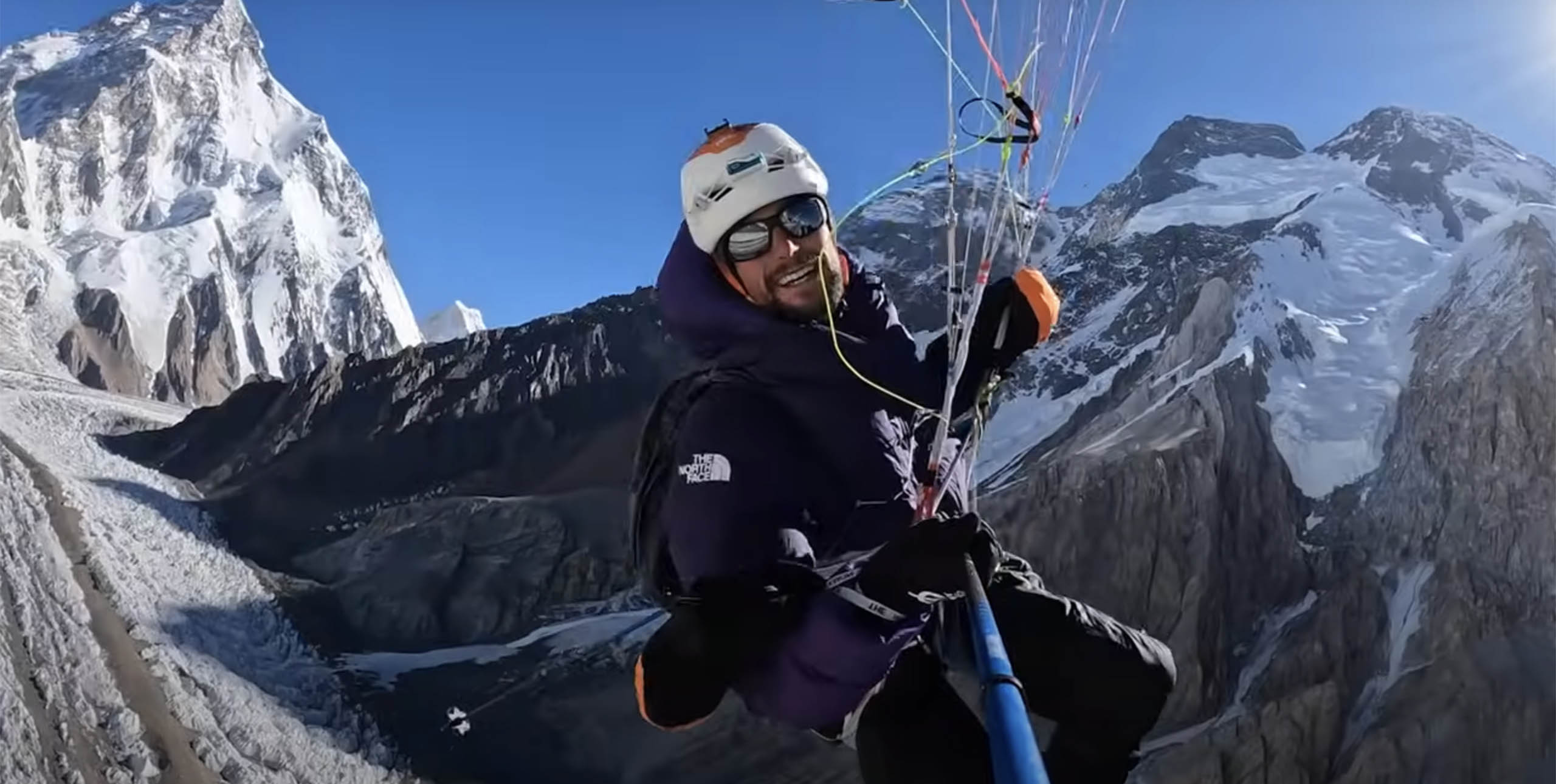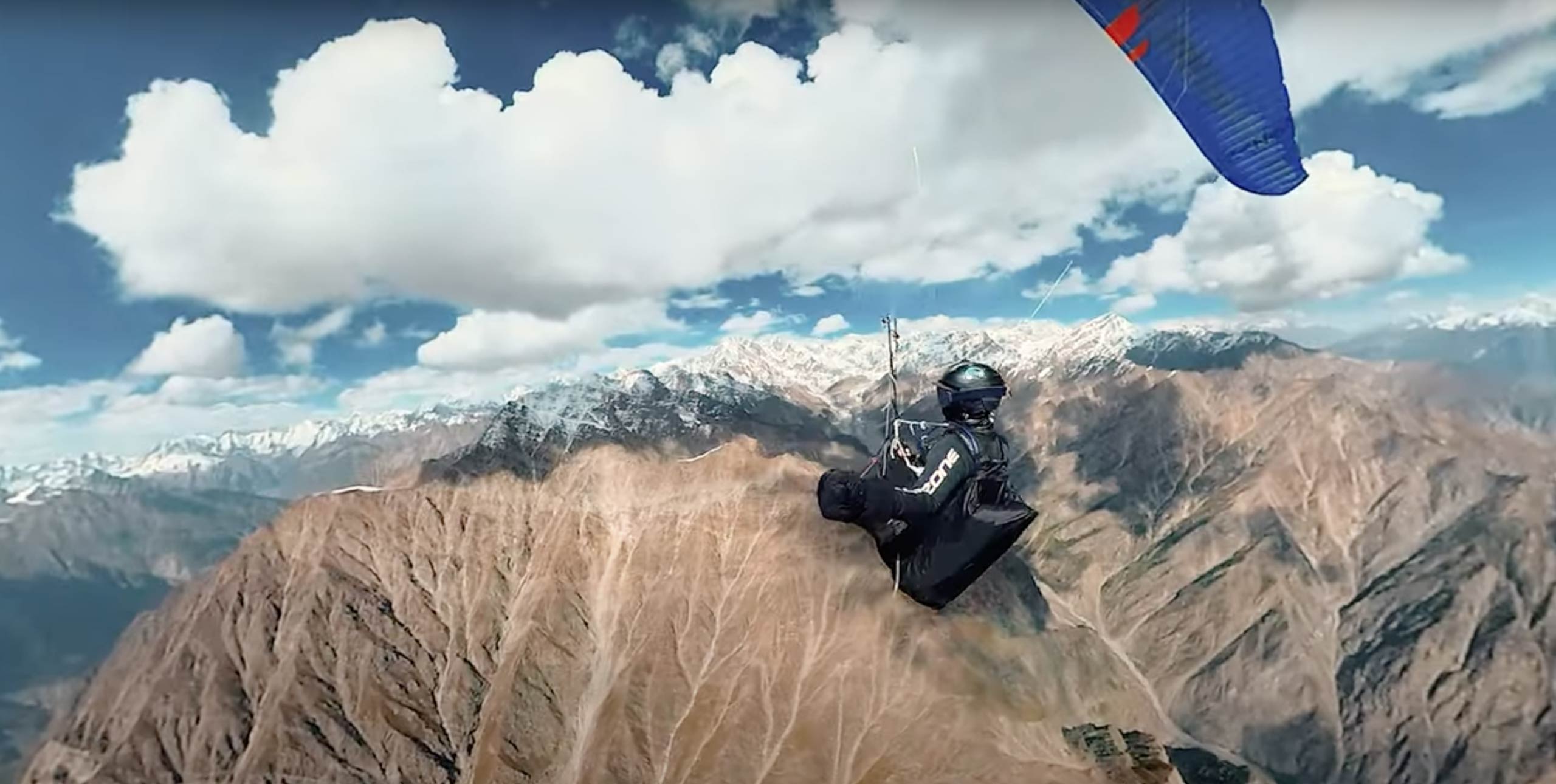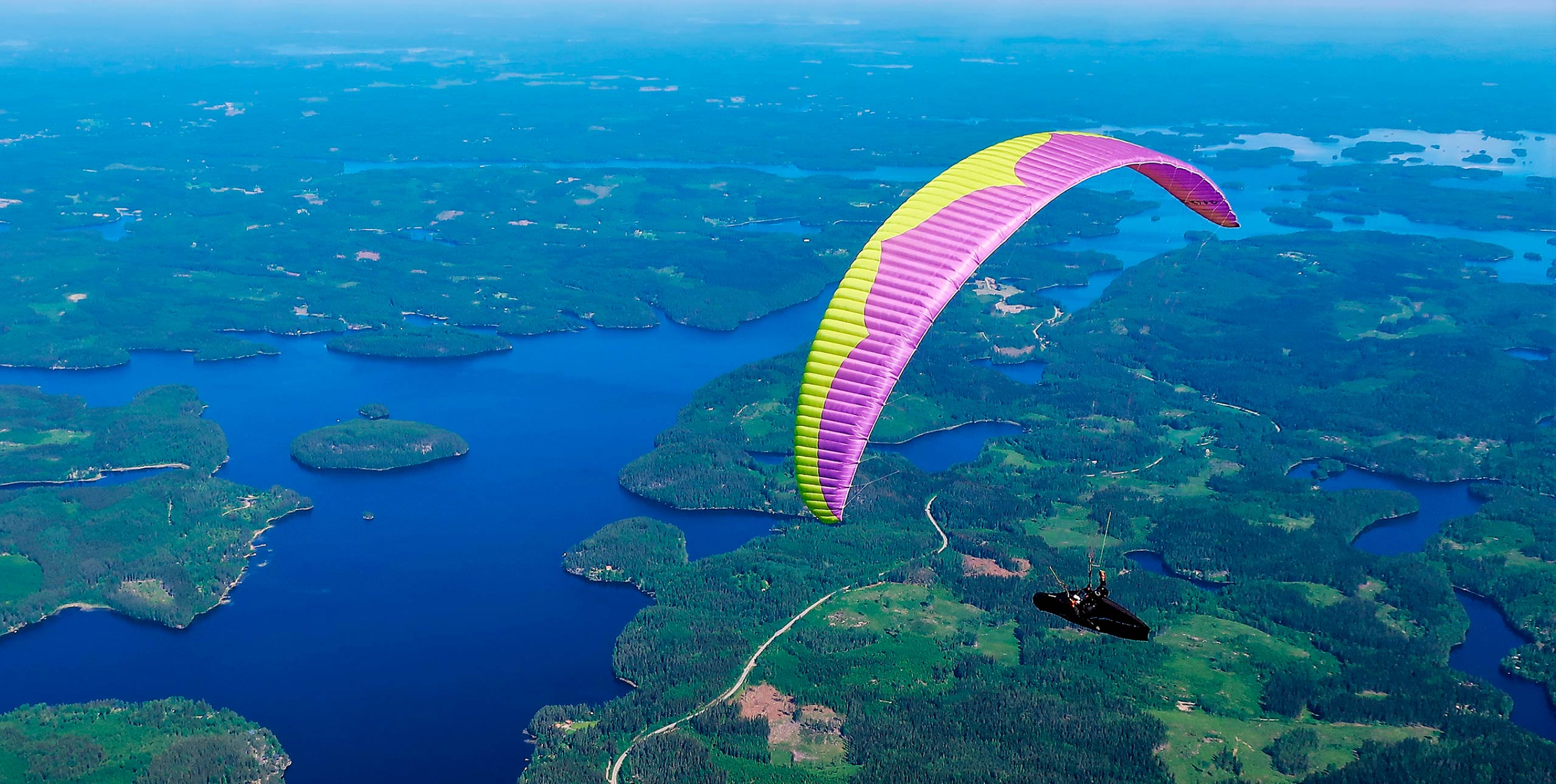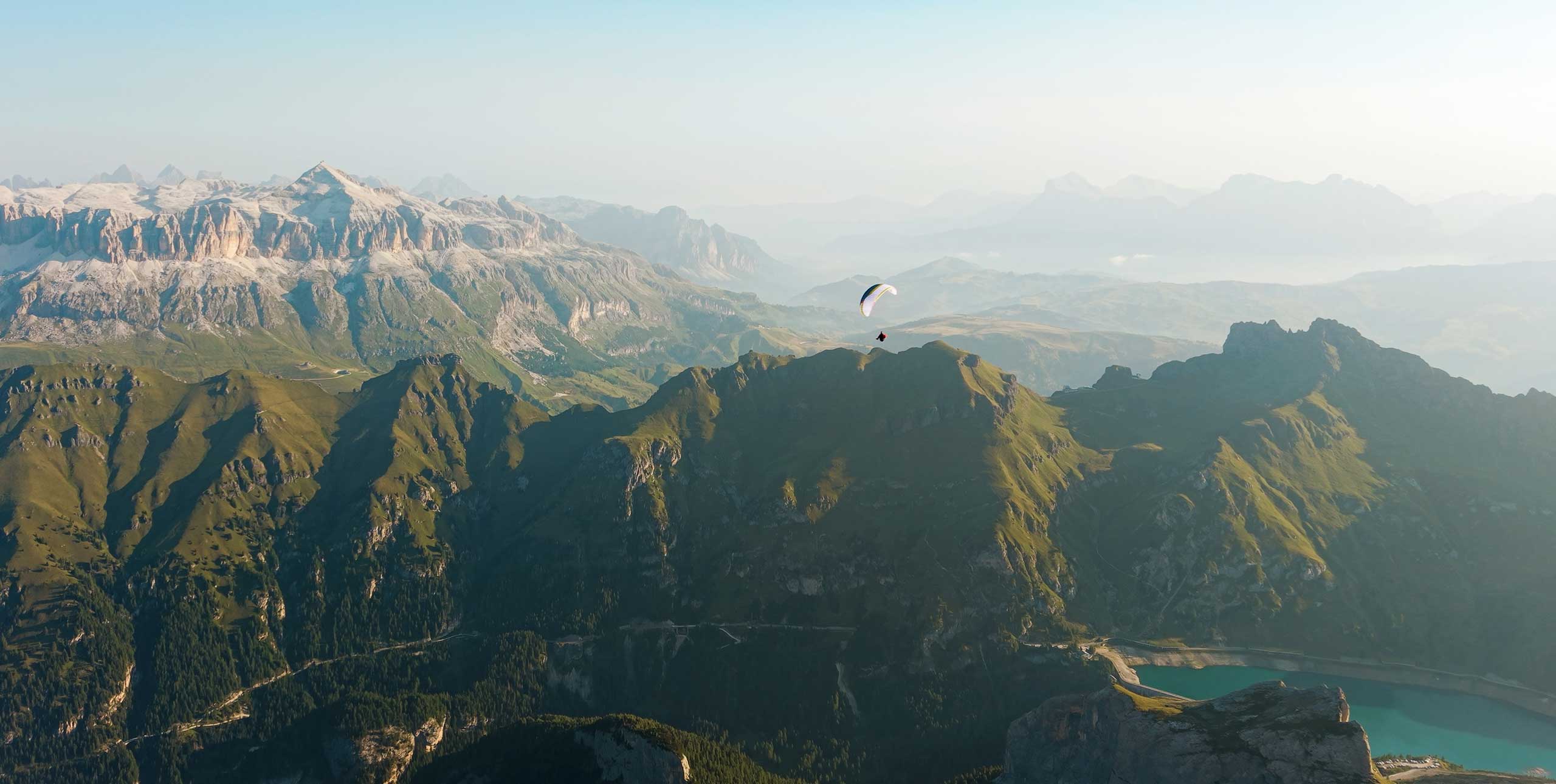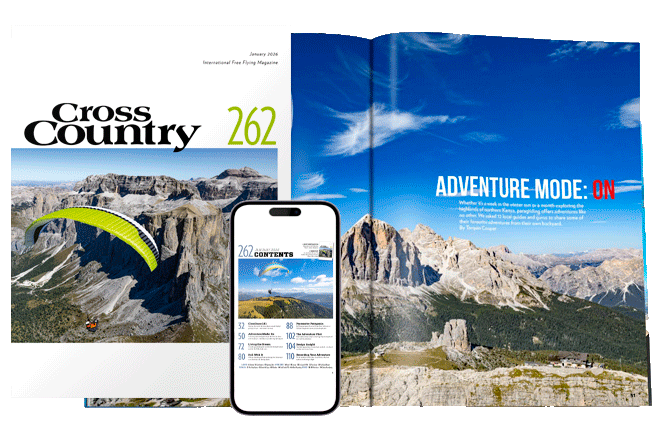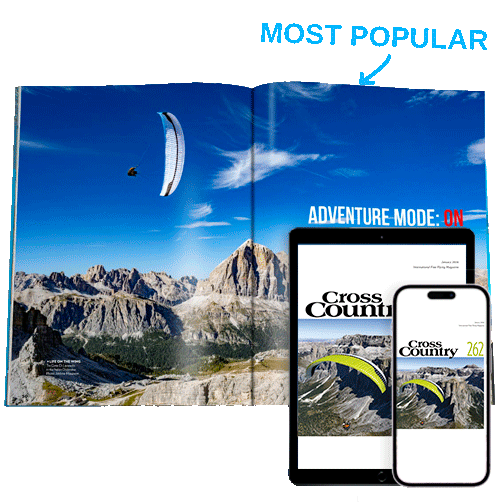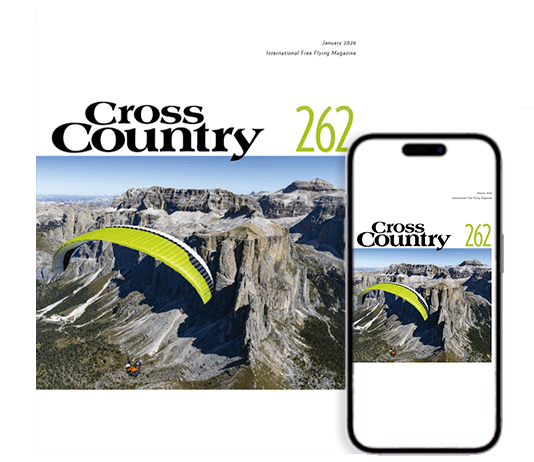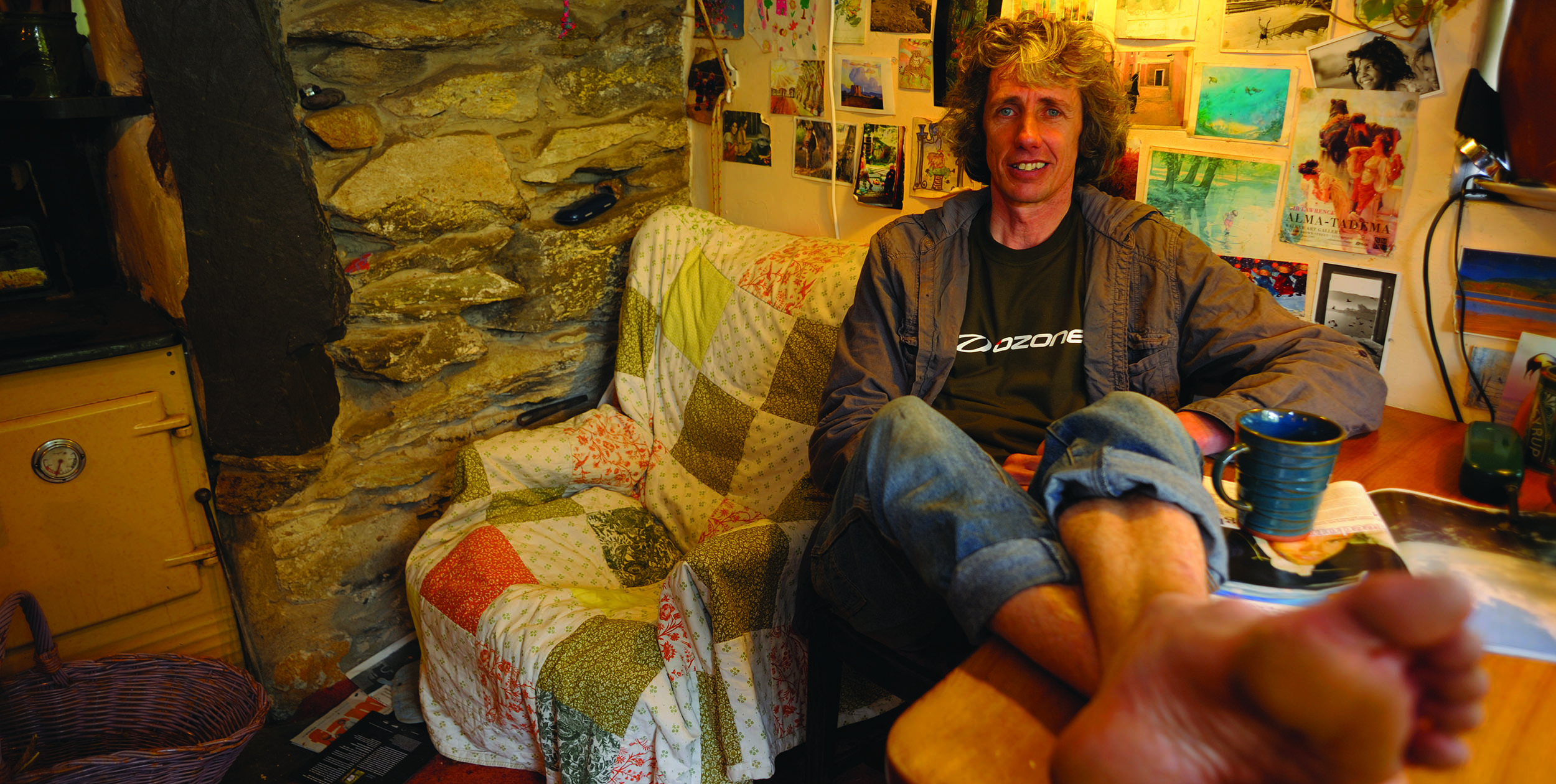
Hugh Miller interviews paragliding legend John Silvester in this archive article from 2008. At the time of the interview John was preparing to head off to the Karakoram for a unique tandem vol-biv adventure – the film of that trip became the legendary Birdman of the Karakoram
I’ve wanted to interview John for ages. Two reasons. Back in 1995, when I was 18, John gave me a ride around the European World Cup circuit in his knackered old Renault Master campervan, and became something of an uncle to me. My parents drove me to a rendezvous point on the way to Dover and patiently waited for John to show up. He’d bought the van for £300, and it’d already seen him round four seasons before he lumbered into the Essex services (at midnight – no road tax – less chance of getting done by the police).
When John’s bedraggled long-haired and scruffily-dressed, rangy frame emerged from the rusty side-door, only the polite repression of the English upper classes prevented my parents from asking what the fuck was going on. Anyhow, I digress – one wet evening later that summer, we were cooking in his van and John wondered out loud what I might be doing in 10 years’ time. I was flattered by his friendship and interest in my future, and that catch-up is three years overdue.
Secondly, John is completely out there. Completely. Flying circuits around 8,000 m mountains, opening up wild new Himalayan routes – then coming home and near-ruining relations with his sponsor by grabbing a nine-year-old glider from a previous sponsor, taking off on a windy day for a punt about on his local site, and then crossing the entire country of Wales to set a new British record (194 km).
His flying feats alone hint at a child-like imagination: dreams unchecked by the blinkering, conditioning and pressures of conformity that constantly press in on us. John smashed the European distance record in 1994, became British champion in 1995, and since 1996, he’s been one of the world’s foremost adventure pilots. A friend of mine, Mark Watts, says every year, “The walls keep getting closer, and you have to keep pushing them back, or they’ll win.” Well John’s got a massive great axe, and no wall’s yet come close.
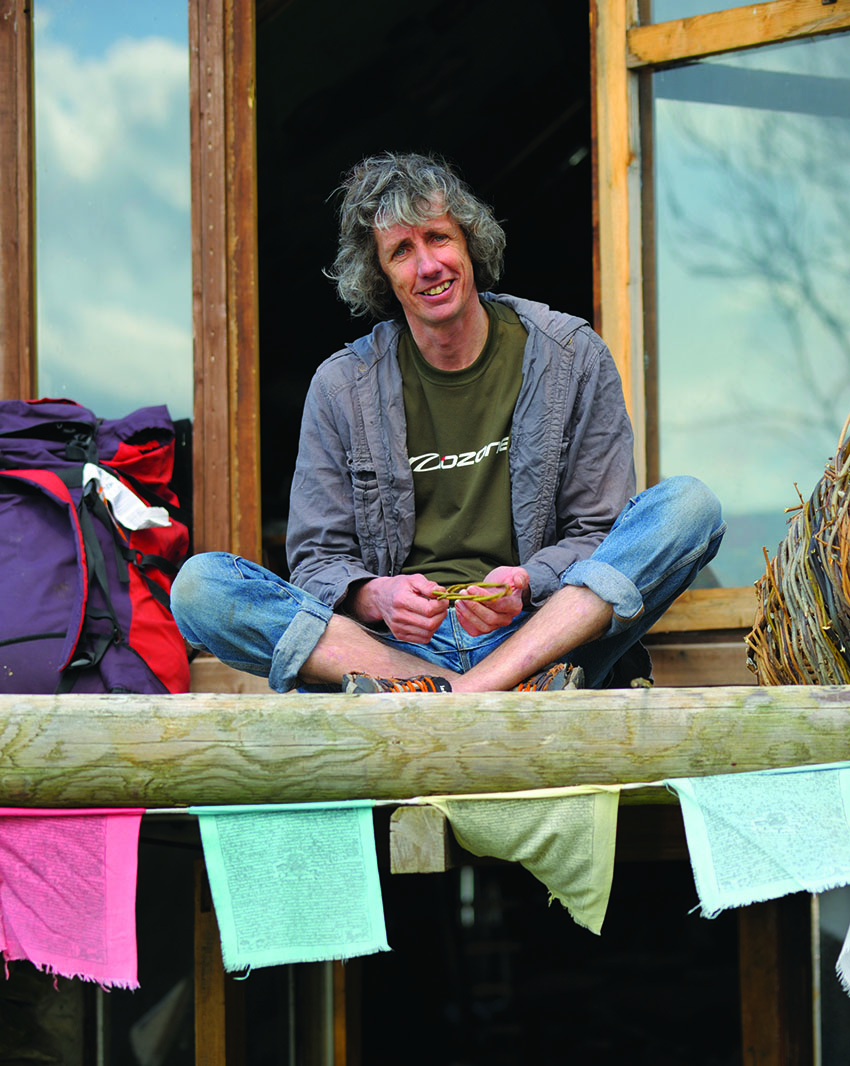
Meet him and that imagination burns bright in his eyes, surrounded by ever-contorting facial expressions and a set of teeth that a witch would be proud of. In fact, when I was a teenager reading the national paragliding magazine, obsessing about success, I used to see John’s picture alongside the clean-cut faces of other top competitors and feel slightly repulsed. What the hell was this wonky-toothed skinny hippy with the disarming smile doing in the national team – had the selectors gone mad?
And the laugh. John has the most alive, infectious laugh I’ve ever heard. It’s as if John can’t physically contain the excitement in his body and it comes steaming out like his throat’s a whistling kettle. If the forecast ever looked half reasonable, John would scream out in falsetto, “It’s gonna be good, I just know it!”
After travelling with John, I used to visit him from time to time at his slate-roofed cottage that he’d renovated himself, camouflaged away on the heavily-mined quarry slopes of North Wales, where he lives with his partner Nicky and children Molly and Dru. We’d chat long into the evening, then I’d crash out on his sofa, hearing the crackle and hiss of the last logs burn out on the stove. We might even go flying – and breath-taking it is too, a 50/50 mix of ridge-soaring and thermalling up from the quarry launch into the tightly packed ridges of Snowdonia.
Right now John is packing his bags for a two- month trip to Pakistan, where he’s going to attempt to fly tandem above the summit of Rakaposhi (7,788 m) and soar to over 8,000m. If he pulls it off it’ll be a mental achievement in itself, but to cap it all he’s going to be flying tandem with Alun Hughes, the filmmaker with whom he produced ‘From Nowhere to the Middle of Nowhere’, the classic 1999 vol bivouac story. And before they even get to Rakaposhi, the pair are going to fly vol-biv style from Pakistan’s capital Islamabad, across Kashmir and the Karakorum.
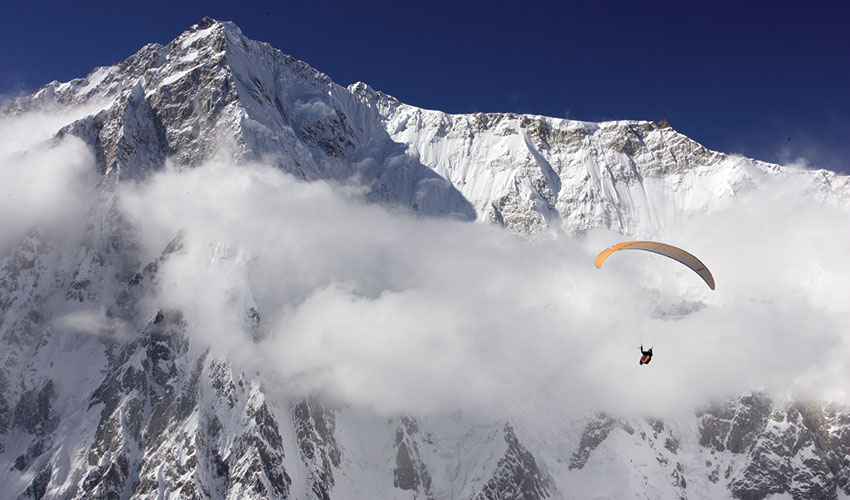
I don’t know about you, but the very idea of such a flight fills me with fear. I’ll stick with my flatlands, thank you very much, and if I get pub-sucked, well so be it. John, however, has a measured approach to risk-taking, and in some way or other, nearly all of his 48 years have been preparing him for just such an adventure. Before starting flying in 1988, John was a most respected climber, and his technical knowledge provides him with a sense of knowing and familiarity in the world’s most monstrously high mountains.
“Knowing I’ve got good mountaineering skills definitely gives me confidence,” he says. “For example, glaciers. If I’m getting drilled, I’ll know which side to land on, and how to walk across one if I absolutely have to. You still definitely don’t want to bomb, but I’d like to think I could survive if I did.”

John also says that moving from climbing on to flying gives a good sense of perspective on the dangers involved.
“Climbing in the Himalaya is fucking dangerous, whereas flying is relatively safe,” he reasons. “You fly alongside these cliff faces, and you see the enormous avalanches, and you just laugh, thinking, ‘That would have killed me if I’d been on that!'”
That’s not to say that Himalayan flying doesn’t have its moments – indeed John recognises that his most fearful times under a paraglider have all been in the Himalaya. After completing his 100km circuit of Nanga Parbat (John was the first person to ever circumnavigate an 8,000m mountain) he says, “I came down a howling valley wind pretty high up in big potato fields. It was blowing 60km/h on the lip of this terrace, with massive dust sheets coming up the valley.
“But apart from that, Nanga Parbat’s an easy, classic route – like the Tour de Mont Blanc!”
John’s glass is forever half full.
But even scarier than the Nanga Parbat landing was the time he got caught out by a big storm while filming From Nowhere with Alun in western Nepal, not knowing what lay beyond.
“We were stuck on a high ridge with no lift, nowhere to safely top-land, a big storm developing quickly, and trying to quell the fear and not run back the way we had come… which was into wind along a nasty high rocky rotory ridge,” he remembers.
“The temptation was so strong to just do something, running away to perceived safety, rather than just waiting in the absolute middle of nowhere as the sky got worse. And then when the climb finally came and we thought we were out, we saw this dreadful view over the back: steep glaciers falling into death canyon.
“But I still set off low on the long glide because I was more scared to take a tandem close to the clouds than chance an iffy glide. Thank God for cloud-sucking good air – but don’t tell Alun!”
The jubilation of escaping from the jaws of doom is written all over John’s face when they finally land – it’s one of the highlights of the film, and is John’s most exciting moment ever in paragliding: “I was totally wired, totally alive!” he remembers. “Never had a post-flight cigarette tasted as good.”
The goal of trying to cross so much dangerous terrain requires a very fixed mindset. “You decide where you want to get to each day, and you damn well get there,” is how it goes, according to Bob Drury, John’s partner on his first ever vol-bivouac. And that’s where the mentality of competition flying plays a crucial role.
“In vol-bivouac flying, each flight is like a defined task. And if you think it’s an achievable task, say a 100km goal in Piedrahita – well, if you didn’t make it, you’d feel like you’d failed,” John says.
“It’s the same when you’re climbing, once you’ve started your route you’ve got to get to the summit. Retreating by abseiling is often a nightmare. Flying in the Himalaya is a bit like that. You think, ‘I will get the climbs over there, I will get up.’ It’s rather liberating actually. Like mountaineering with a paraglider.”
In some ways, each of John’s adventures is like a compressed version of his life. He has carved his path by grit and determination, working small jobs between climbing trips, then securing sponsorship deals in paragliding that allow him to exist and pursue his passion. Very little’s changed since I went travelling with him in the mid-’90s. He’s still piecing together a shoestring existence, pursuing joy in life, wherever that might lead him. It takes a level of conviction that few of us possess, but John describes it simply as “Being authentic with my feelings and living them out. The rest of my life fits around the passion I have.”
“Besides, you don’t need much in life,” he continues. “What do you need? Shelter, food and warmth. Once you’ve got that you can progress.”
“When you travel in the Himalaya, you come across people who’ve lived in the same valleys for generations, never leaving, and their houses and crop fields are sorted. When you land in their midst they all flock round you and spend days just hanging out with you because, frankly, you’re interesting, and they’ve got the time to do so! Imagine that happening in the West!
“Happiness for me is being able to wake up and dig for potatoes,” he continues. “I hate all the adminy stuff; I’d rather do manual labour like building a drystone wall. You get into a zen-like mind state, fitting rocks into a big jigsaw puzzle. You’re engaged.”
It gets me thinking about the popular psychological theory that we can only truly be happy when we are present, accepting of who we are in the moment, not caught up with anxiety about our future or miserable about the past. Living in the moment is something that helps John in his flying, too. He tries to keep his attitude to each flying day at home in Wales open, and without expectation.
“I’ve been amazed at some of the crappy days you can go XC on,” he says. “Last summer was shit, and I was so desperate to fly. We were up at the Garrett with a 2,000ft base, and there were only four of us there, and it looked crap, in fact it was crap, but I still got as far as Wenlock, 123km away!
“It’s often liberating to just go XC without a big objective or fear of failing, just that desire to keep on flying and exploring, and see where the day takes you. I have been surprised so many times.”
If I’m honest, what I really want to nail in this interview is a flavour of what paragliding means to John. It must be something pretty special – he’s still as obsessed by flying as he was 20 years ago. But I’m well aware that if someone asked me the same question, I’d be stumped, struggling for words that would never capture the emotional elation that flying gives me. Fortunately, John is rather more articulate than me.
“It’s all about freedom,” he says. “When you take off there’s nothing to think about but flying. When you watch a kid, they’re 100% absorbed in something really simple, like playing in the sand. That’s it, there’s not a flicker of anything else on their horizon. It’s the same for me in flying.
“And there’s not many ways you can get into the wild in such a brief amount of time. Some of my best days at home, I’ll have been running about all day, then I get out at 6pm and go up to base for an hour, and then land back by my car. And in the Himalaya you’re launching pretty much at the base of the valley and you can be up at six thou’ less than half an hour later.”
John’s achieved so much in the sport, in such a humble manner, that I wonder how he feels about his own attitude towards success. When he broke the UK record, I spoke to him on the phone and he was very dismissive of the flight, saying in a hush-hush voice, “It was really easy actually, Hugh. Anyone could have done it!”
But he’s not coy about the rewards success gives him. “In climbing, we’re surrounded by books by old climbers who talk about the risks they took when they were younger to prove themselves. It’s a natural thing. But for me, now, it’s just really nice when someone comes up and says, ‘Remember when you did so-and-so?’ Because it fertilises my memory, makes it more real.
“And nowadays, I get a huge buzz off hearing what Julien Wirst, Luc Armant and Philippe Nodet are getting up to in the Himalaya. We have huge respect for each other. In fact, I think Luc has already made the ultimate vol-bivouac. His flight along the front face of the Himalaya is most definitely the aesthetic classic.”
So who’s influenced John on his path?
“I’d like to say the pilot I learnt the most from was Donald Shimoda, the travelling barnstorming bi-plane pilot in Richard Bach’s Illusions, who sleeps on the grass underneath his fuselage, and cooks great pan bread on open fires,” he replies. “Definitely inspirational stuff to a fledgling Himalayan bivvy pilot. But really, it was Rob Whittall.”
It’s easy to see why the pair struck up a friendship when they met in the early 1990s. Rob and John share a level of self-belief that translates to a ballsy, committed flying style which no doubt earned each other mutual respect. They both also don’t mind telling people what they think when they really feel they need to. In John’s case, some of this might stem from a tragic accident during the third day of a winter ascent in the French Alps.
“My biggest regret is not throwing a rope to [a pair of] Japanese climbers at the top of the Grandes Jorrasse. Simon Yates and I were only 700ft from the top, with a storm coming in. I led the second-to-last pitch, the hardest mixed pitch I ever did, so worryingly bad I even dropped an ice-tool.
“Hanging on the belay bringing up Simon, I thought hard about waiting for half an hour so the Japanese climbers who had been following us could catch up and I could throw them a rope. But somehow I persuaded myself that it was too egotistical to assume that just because I had thought it so hard and serious, that they would too. And if someone had thrown me a rope – would I have taken it?
“So I didn’t, then half an hour later, whilst Simon was just finishing the next pitch, came the screams. Then silence. The peg must have ripped – and then the belay. All that was left was a 3,000ft fall. And that is why I now sometimes have to speak my mind…
“When I was younger I thought everyone had their own envelope that they could push as much as they wanted, but sometimes you have to be solid about your judgements and tell people who’re less experienced than you,” he reasons.
“Don’t get me wrong. I hate authority and I hate people telling me what to do. But on the Jorasses, I made the wrong decision. If I’d really looked at it, it was a big face and we were climbing really well, and I should have thrown them the rope.”
I’ve no doubt that John will look after Alun like a brother when they set off from Islamabad next week. Reading back over this piece, I’m left with a sense that there’s something missing. Perhaps it’s John’s sense of caring, his loyalty to his friends, and his optimism – always seeing the best in others. Maybe it’s also his often contrary, fiery nature – John is not shy in a discussion, but will always change his view if presented with enough evidence to do so. Whatever it is, I’m always left with a warm, alive glow after seeing John.
And although I struggle to comprehend the scale of his adventures, John as a person is always instantly graspable. His humanity, humbleness and connection to the joy of life seem unwavering as he surfs from one day to the next, whether digging for crops or thermalling up to the stratosphere (quite literally – convection usually stops at 7,500m, and John plans to ridge soar the remaining 500m to his golden 8,000m goal over Rakaposhi).
I’ll never quite do him justice. Let’s just say he’s a human being living his full potential. Flying is in his bones, its joy radiates through his eyes, his smile, his laugh. And it’s no gift. John’s life, like his adventures, is entirely of his own making.
It’s gonna be good!
This profile of John Silvester was first published in Cross Country 117 (May/June 2007). John Silvester died of a heart attack at home in Wales on 23 May 2021, he was 60. He is survived by his partner Nicky and two grown-up children, Molly and Dru



